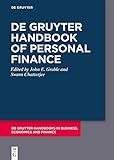De Gruyter Handbook of Personal Finance / ed. by John E. Grable, Swarn Chatterjee.
Material type: TextSeries: De Gruyter Handbooks in Business, Economics and FinancePublisher: Berlin ; Boston : De Gruyter, [2022]Copyright date: ©2022Description: 1 online resource (XXIII, 629 p.)Content type:
TextSeries: De Gruyter Handbooks in Business, Economics and FinancePublisher: Berlin ; Boston : De Gruyter, [2022]Copyright date: ©2022Description: 1 online resource (XXIII, 629 p.)Content type: - 9783110727494
- 9783110727708
- 9783110727692
- 332.024
- HG179 .D42 2022
- online - DeGruyter
- Issued also in print.
| Item type | Current library | Call number | URL | Status | Notes | Barcode | |
|---|---|---|---|---|---|---|---|
 eBook
eBook
|
Biblioteca "Angelicum" Pont. Univ. S.Tommaso d'Aquino Nuvola online | online - DeGruyter (Browse shelf(Opens below)) | Online access | Not for loan (Accesso limitato) | Accesso per gli utenti autorizzati / Access for authorized users | (dgr)9783110727692 |
Frontmatter -- Contents -- List of Contributors -- Preface -- Part I: Introduction to the Discipline of Personal Finance -- 1 Defining Personal Finance -- 2 Personal Finance: A Policy and Institutional Perspective -- 3 Personal Finance: A Practice Perspective -- 4 Personal Finance: An International Perspective -- 5 Theories of Personal Finance -- Part II: Saving, Investing, and Asset Management -- 6 Budgeting and Cash Flow Management -- 7 Patterns of Asset Ownership -- 8 Approaches to Saving -- 9 Financial Risk Tolerance -- 10 Accounting for Time When Saving and Investing -- 11 Household Financial Ratios -- 12 Income, Income Transfers, and Taxes -- 13 The Use of Credit in the Consumer Marketplace -- 14 Debt and Mortgage Choices -- 15 Considerations when Planning for Retirement -- 16 Generating Income in Retirement Using Systematic Withdrawal Strategies with Investments -- 17 Small Business Ownership: Impact of the Lack of Transparency and Separation on Small Business Finances -- 18 Applying Investing Theory to Practice -- Part III: Financial Security -- 19 The Role of Insurance as a Household Financial Management Tool -- 20 Health and Financial Well-Being -- 21 Household Debt Behavior -- 22 Financial Security: Protecting the Health of Consumers -- 23 Accounting for Retirement Asset Distributions during the Decumulation Stage of Life -- 24 The Evolution of Financial Services in the Digital Age -- Part IV: Future Directions -- 25 Behavioral Economics and Financial Decision Making -- 26 The Role of Socialization in Shaping Personal Finance Attitudes and Behaviors -- 27 Measuring and Applying Financial Literacy -- 28 Money Psychology: Beliefs and Behaviors about Investing, Saving, and Spending -- 29 Financial and Relationship Satisfaction -- 30 The Growing Role of FinTech and Robo-advisors -- 31 The Use of Financial Advice: Consumers’ Financial Advice-Seeking -- 32 The Future of Payments: Cash, Cryptocurrencies, and Peer-to-Peer Payments -- Part V: Summarization -- 33 Personal Finance Research: An Editor’s Perspective -- 34 The Future of Personal Finance: An Educational and Research Agenda -- List of Figures -- List of Tables -- About the Editors -- Index
restricted access online access with authorization star
http://purl.org/coar/access_right/c_16ec
The De Gruyter Handbook of Personal Finance provides a robust review of the core topics comprising personal finance, including the primary models, approaches, and methodologies being used to study particular topics that comprise the field of personal finance today. The contributors include many of the world’s leading personal finance researchers, financial service professionals, thought leaders, and leading contemporary figures conducting research in this area whose work has shaped—and continues to affect—the way that personal finance is conceptualized and practiced. The first section of the handbook provides a broad introduction to the discipline of personal finance. The following two sections are organized around the core elements of personal finance research and practice: saving, investing, asset management, and financial security. The fourth section introduces future research, practice, and policy directions. The handbook concludes with a discussion on an educational and research agenda for the future. This handbook will be a core reference work for researchers, financial service practitioners, educators, and policymakers and an excellent supplementary source of readings for those teaching undergraduate and graduate-level courses in personal finance, financial planning, consumer studies, and household finance.
Issued also in print.
Mode of access: Internet via World Wide Web.
In English.
Description based on online resource; title from PDF title page (publisher's Web site, viewed 02. Mai 2023)


